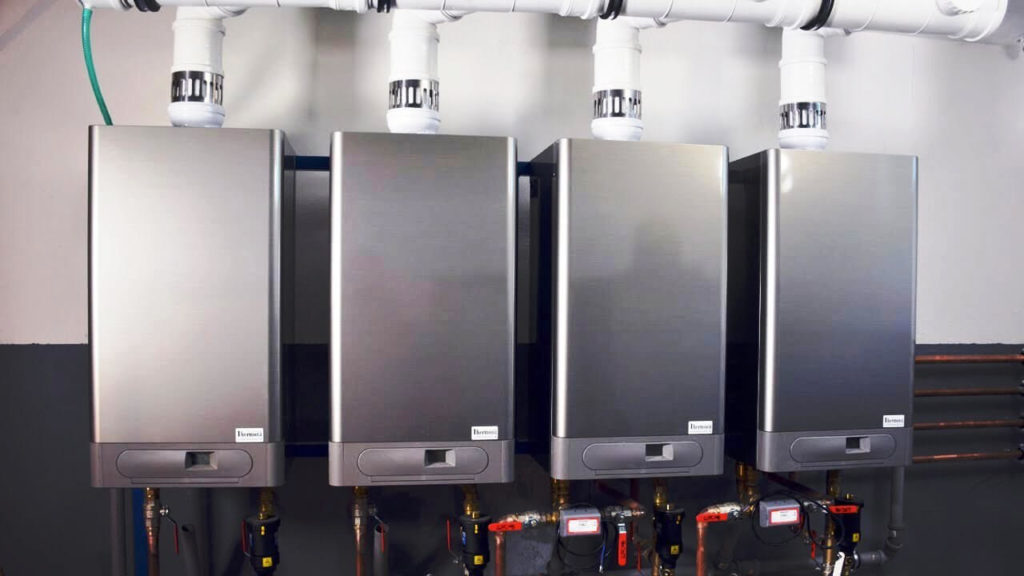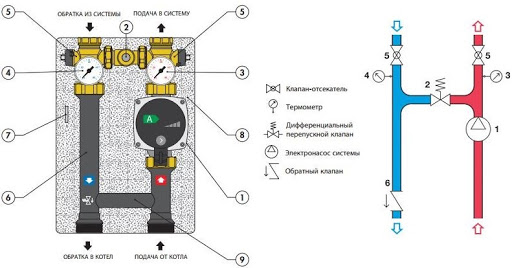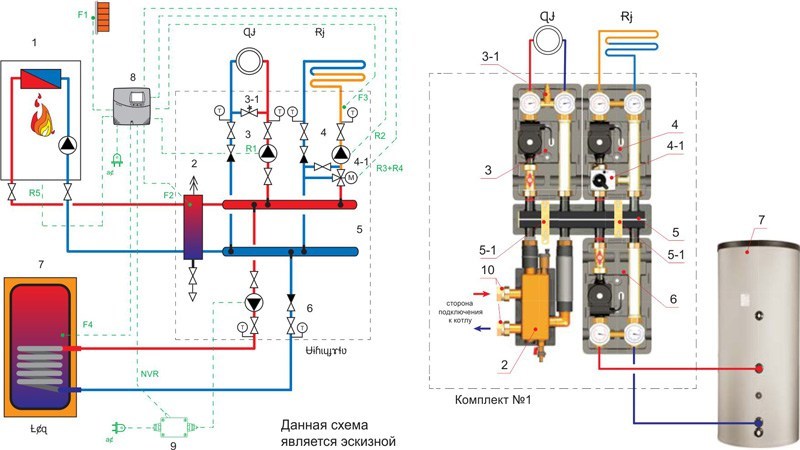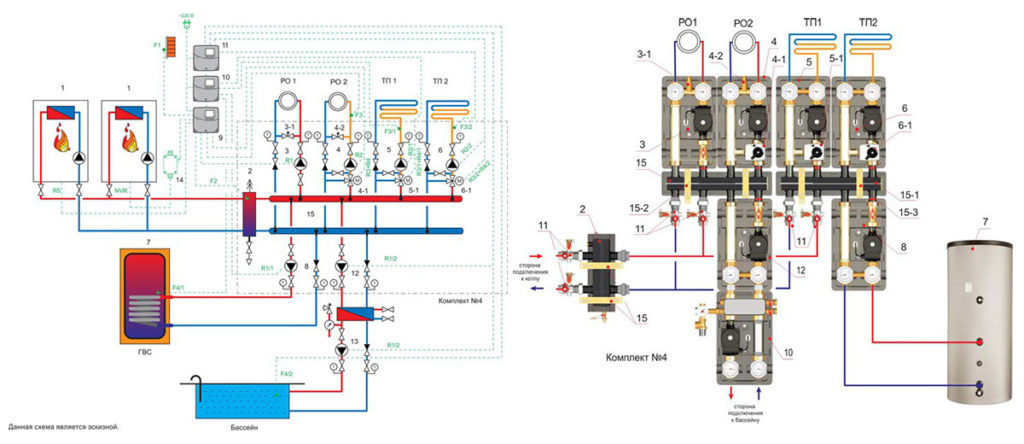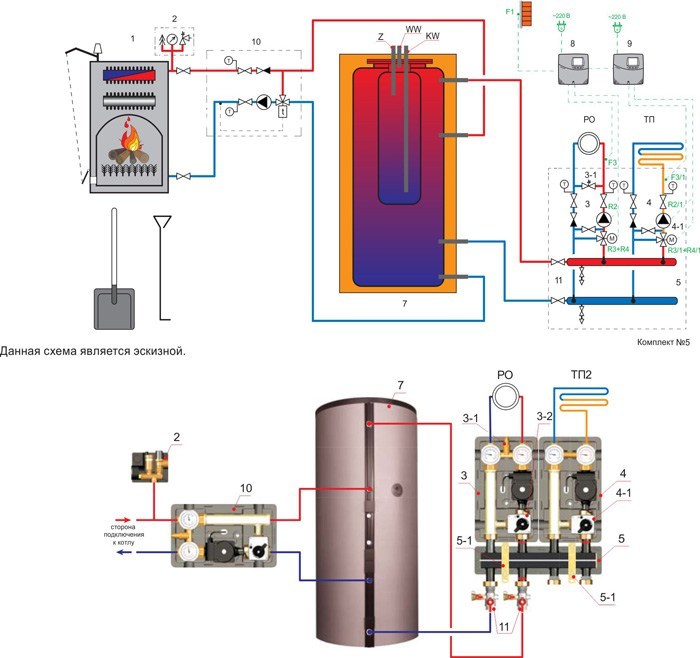Commonly used boiler fittings. Pumping groups
Installation of boilers requires the development of a thermal circuit and the correct selection of equipment. This applies, first of all, to the correct connection of the heating circuits, but fittings for heating systems will also be required. For example, a traditional single-loop binding has one major drawback. All radiators are heated at different temperatures. The coldest heating device in the system turns out to be the most distant. The problem can be solved in two ways: with circuits with a maximum of 3 radiators or with pre-regulated valves. How to equalize the temperature in batteries, we told in one of the previous publications.
Legend:
1 - Pump
2 - Differential bypass valve (option)
3 - Supply thermometer
4 - Thermometer on the return
5 - Shut-off valves of the secondary circuit
6 - the Connecting tube (with a check valve)
7 - a rod wrench for shutoff valves of the secondary circuit
8 - Insulation
9 - Spacer
To simplify the task of setting up a heating system using valves, many craftsmen connect each radiator to a heating manifold. This approach is costly and inconvenient due to multiple pipe routing, but guarantees more accurate manual settings. Today we will look at a similar approach to fast installation with guaranteed quality.
Heating boiler circuit - connection via a pump group
It is customary to separate boilers into a separate circuit, which is supplied with its own circulation pump and the necessary fittings. In the classic case, we are talking about an expansion tank, a thermostat and a safety group. The pumping group for connecting the boiler can be supplied as a complete unit in one module.
For installation, the so-called fast assembly systems are used. Pumping groups can:
- have a specific purpose;
- provide conditions for connecting boiler generators and heat consumers;
- be designed for systems with certain parameters.
The purchase of such modules greatly simplifies the complexity of installation work, but increases the quality and reliability. But at the same time, there is a significant increase in cost than when using a set of fittings for heating systems.
The figures show examples of connecting boilers and heating circuits using pump groups.
Example 1
The heating system is based on the operation of the main boiler with a capacity of 40 kW, which is designed for two heating circuits: a radiator with a capacity of 35 kW and a heated floor with a capacity of 15 kW. The system has an indirect heating boiler with a capacity of 50 kW and a volume of 300 liters. Water heating is used all-season.
Legend:
- 1 - boiler;
- 2 - hydraulic arrow;
- 3 - high-temperature type straight circuit;
- 3-1 - bypass valve;
- 4 - underfloor heating mixing circuit;
- 4-1 - mixer servomotor;
- 5 - a collector for 3 inputs;
- 5-1 - mounting kit;
- 6 - supply circuit to the indirect heating boiler;
- 7 - indirect heating water heater;
- 8 - weather-dependent regulator;
- 9 - relay 12V / 220V;
- 10 - a device for connecting a hydraulic arrow;
- F1, F2, F3, F4 - temperature sensors.
The use of pumping groups allows you to quickly and without errors perform piping of a boiler room of any complexity. In fact, they are a constructor for connecting any types of boilers to systems of any complexity and type. The solution includes all the necessary fittings - taps, thermometers, valves, bypasses and more. The models are supplied with and without a pump, this is done so that the buyer can choose a circulation module for his heating system. In this case, the installation of the device takes no more than 10 minutes.
The advantage of using pumping groups is the practical elimination of installer errors. In addition, such equipment is made of high quality and durable materials.
Example 2
The heating system of the house includes two 60 kW boilers with cascade connection. The modulated capacity of the equipment is planned to be used for heating two radiator circuits, two circuits of the "warm" floor and heating a pool of 20 kW. It is also planned to heat the hot water treatment tank. The DHW circuit has an all-season purpose and its maintenance is a priority. Heating system fittings are assembled from ready-made pumping groups.
Legend:
- gas boiler;
- hydraulic arrow;
- 3 - circuit of high-temperature heating of the house (circuit No. 1);
- 3-1, 4-2 - built-in bypass valve;
- 4 - high-temperature heating circuit (mixing, circuit No. 2);
- 5 - low-temperature (mixing, circuit No. 1);
- 6 - low-temperature (mixing, circuit No. 2);
- 4-1, 5-1, 6-1 - mixer electric drive;
- 7 - hot water boiler;
- 8 - water supply circuit to the hot water tank (straight line);
- 12 + 13 - pool heating circuit (circuit with heat exchanger);
- 11 - shut-off valves with union nuts 1 1/2 '' and drain / fill taps;
- 9 - weather-dependent regulator;
- 10, 11 - expansion regulators;
- 14 - relay 12V / 220V;
- 15, 15-1 - collector for 5 circuits;
- 15-2, 15-3 - mounting kits;
- F1 - outside air temperature sensor;
- F2, F3, F3 / 1, F3 / 2, F 4/1, F 4/2 - surface-mounted coolant temperature sensors.
Example 3
Connecting a solid fuel boiler through a pumping group. A solid fuel boiler with radiator heating for 30 kW and a floor heating system for 10 kW are installed in the house, and a 300-liter indirect heating boiler for hot water supply is also installed.
Legend:
- one - solid fuel boiler 40 kW;
- 2 - security group;
- 3 - mixing circuit for high-temperature heating;
- 4 - mixing circuit for low-temperature heating;
- 5 - 3-circuit collector;
- 7 — buffer capacity of the combined type;
- 8 - basic regulator;
- 9 - expansion regulator;
- 10 - low-temperature corrosion protection module (maintains the return temperature);
- WW - tap for hot sanitary water outlet;
- KW - tap for cold sanitary water;
- Z - recirculation pipe;
- F1 - outside air temperature sensor;
- F3, F3 / 1 - temperature sensors for straight pipelines.
Example 4
It is required to ensure the operation of the electric boiler at the night rate and support the basic heating. Solid fuel boiler should be connected automatically when the temperature of the coolant drops. Heating is designed for 30 kW high temperature circuit and 7 kW low temperature circuit. The system has a 200 liter domestic hot water boiler. The system is designed in such a way that the fittings for heating systems are used within the models of the existing pumping groups.
Legend:
- 1 - electric boiler;
- 2 - solid fuel boiler;
- 3 - pumping group with protection against low-temperature corrosion;
- 4 - heat accumulator;
- 5 - weather-dependent regulator;
- 6 - collector for 3 circuits;
- 6-1 - mounting kit;
- 7 - direct high-temperature circuit;
- 7-1 - bypass valve;
- 8 - mixing low-temperature circuit;
- 8-1 - mixer servomotor;
- 9 - boiler loading (direct);
- 10 - boiler for indirect heating of hot water supply;
- 11.12 - relay 12V / 220V;
- 13 - regulator.
Assortment of pumping groups on the example of the Termojet brand
On sale you can find pumping modules and fittings for heating systems of the following types:
- pumping groups with a three-way valve for connecting high-temperature and low-temperature heating circuits with the necessary admixture of raw water;
- groups without a mixer are used to connect radiator, hot water and ventilation circuits;
- pumping groups with a dividing circuit are designed to connect a "warm" floor if air locks appear in the system, installation of an icing circuit, an external water heating circuit in the pool and for other purposes;
- circuits with a thermostat are used to regulate the temperature indicators of high and low temperature heating circuits;
- groups with a thermostat on the return line are used for anti-corrosion protection of low-temperature circuits.
The use of pumping groups allows you to perform part of the installation work without the invitation of the master. The pump groups are premium quality heating fittings for fast work progress.
Order a boiler room project for a home
Standard fittings for boiler rooms

